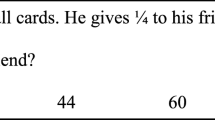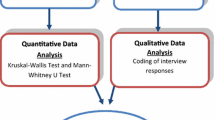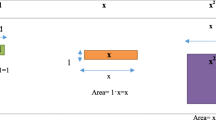Abstract
The aim of the current study was to investigate whether exposing teachers to theoretical and empirical background information regarding pedagogical aspects of geometrical thinking would affect their noticing abilities. Forty-one in-service Mathematics teachers participated in this study. The research tools used in the study included a lesson taken from the VIDEO-LM project and articles that were all presented to the teachers. Our work with an open-ended questionnaire and mixed-methods analysis revealed that exposing in-service teachers to theoretical and empirical articles may affect the three components of their professional noticing performance: attending, interpreting, and responding. After the exposure to the articles, the teachers exhibited a greater focus on the specific difficulties inherent in the specific task at hand and their subsequent interpretations of those difficulties and responses to those difficulties were also more specific than they had been before the intervention.









Similar content being viewed by others
Data availability
The data that support the findings of this study are available on request from the corresponding author.
References
Ball, D. L., Thames, M. H., & Phelps, G. (2008). Content knowledge for teaching: What makes it special. Journal of Teacher Education, 59(5), 389–407. https://doi.org/10.1177/2F0022487108324554
Bastian, A., Kaiser, G., Meyer, D., Schwarz, B., & König, J. (2021). Teacher noticing and its growth toward expertise: An expert–novice comparison with pre-service and in-service secondary mathematics teachers. Educational Studies in Mathematics, 1–28. https://doi.org/10.1007/s10649-021-10128-y.
Bernabeu, M., Moreno, M., & Llinares, S. (2021). Primary school students’ understanding of polygons and the relationships between polygons. Educational Studies in Mathematics, 106(2), 251–270. https://doi.org/10.1007/s10649-020-10012-1.
Charmaz, K., & Belgrave, L. L. (2007). Grounded theory. John Wiley & Sons.
Choppin, J. (2011). The impact of professional noticing on teachers’ adaptations of challenging tasks. Mathematical Thinking and Learning, 13(3), 175–197. https://doi.org/10.1080/10986065.2010.495049.
Ebby, C., & Petit, M. M. (2018). Using learning trajectories to elicit, interpret, and respond to student thinking. In E. A. Silver & V. L. Mills (Eds.), A fresh look at formative assessment in mathematics teaching (pp. 81–101). National Council of Teachers of Mathematics.
Fujita, T. (2012). Learners’ level of understanding of the inclusion relations of quadrilaterals and prototype phenomenon. The Journal of Mathematical Behavior, 31(1), 60–72. https://doi.org/10.1016/j.jmathb.2011.08.003.
Fujita, T., & Jones, K. (2007). Learners’ understanding of the definitions and hierarchical classification of quadrilaterals: Towards a theoretical framing. Research in Mathematics Education, 9(1–2), 3–20. https://doi.org/10.1080/14794800008520167.
Glaser, B., & Strauss, A. (1967). Grounded theory: The discovery of grounded theory. Sociology the Journal of the British Sociological Association, 12, 27–49.
Gibson, S. A., & Ross, P. (2016). Teachers’ professional noticing. Theory into Practice, 55(3), 180–188.
Gutiérrez, A., & Jaime, A. (1999). Preservice primary teachers’ understanding of the concept of altitude of a triangle. Journal of Mathematics Teacher Education, 2(3), 253–275. https://doi.org/10.1023/A:1009900719800.
Haj-Yahya, A. (2020). Do prototypical constructions and self-attributes of presented drawings affect the construction and validation of proofs? Mathematics Education Research Journal (MERJ), 32, 685–718.
Haj-Yahya, A. (2021). Can a number of diagrams linked to a proof task in 3D geometry improve proving ability? Mathematics Education Research Journal (MERJ), 1–22. https://doi.org/10.1007/s13394-021-00385-8
Haj-Yahya, A., Hershkowitz, R., & Dreyfus, T. (2016). Impacts of students' difficulties in constructing geometric concepts on their proof's understanding and proving processes. In Csíkos, C., Rausch, A., & Szitányi, J. (Eds.). Proceedings of the 40th Conference of the International Group for the Psychology of Mathematics Education (Vol. 2, pp. 345–352). PME.
Haj-Yahya, A., & Olsher, S. (2020). Preservice teachers’ experiences with digital formative assessment in mathematics. International Journal of Mathematical Education in Science and Technology, 1–19. https://doi.org/10.1080/0020739X.2020.1842527
Hershkowitz, R. (1989). Visualization in geometry - Two sides of the coin. Focus on Learning Problems in Mathematics, 11(1), 61–76.
Hershkowitz, R., Ben-Chen, D., Hoyles, C., Lappan, G., Mitchelmore, M., & Vinner, S. (1990). Psychological aspects of learning geometry. In P. Nesher & J. Kilpatrick (Eds.), Mathematics and cognition (pp. 70–95). Cambridge University Press.
Jacobs, V. R., Lamb, L. L., & Philipp, R. A. (2010). Professional noticing of children’s mathematical thinking. Journal for Research in Mathematics Education, 41(2), 169–202. https://doi.org/10.5951/jresematheduc.41.2.0169.
Karsenty, R., & Arcavi, A. (2017). Mathematics, lenses and videotapes: A framework and a language for developing reflective practices of teaching. Journal of Mathematics Teacher Education, 20(5), 433–455. https://doi.org/10.1007/s10857-017-9379-x.
Kilic, H. (2018). Pre-service mathematics teachers’ noticing skills and scaffolding practices. International Journal of Science and Mathematics Education, 16(2), 377–400. https://doi.org/10.1007/s10763-016-9784-0.
Kosko, K. W., Ferdig, R. E., & Zolfaghari, M. (2021). Preservice teachers’ professional noticing when viewing standard and 360 video. Journal of Teacher Education, 72(3), 284–297. https://doi.org/10.1177/2F0022487120939544.
Lewins, A., & Silver, C. (2007). Using software in qualitative research: A step-by-step guide. Sage.
Machalow, R., Remillard, J. T., Van Steenbrugge, H., & Kim, O. K. (2020). How curriculum materials support teachers’ noticing of student thinking. In J. T. Remillard & O. K. Kim (Eds.), Elementary mathematics curriculum materials (pp. 195–226). Springer.
Mason, J. (2002). Researching your own practice: The discipline of noticing. Routledge-Falm.
Rosch, E. (1978). Principles of categorization. In E. Rosch & B. B. Lloyd (Eds.), Cognition and categorization (pp. 27–48). Erlbaum.
Rosch, E., & Mervis, C. (1975). Family resemblances: Studies in the internal structure of categories. Cognitive Psychology, 7, 605–773. https://doi.org/10.1016/0010-0285(75)90024-9.
Saldaña, J. (2015). The coding manual for qualitative researchers. Sage.
Shepard, L. A., Penuel, W. R., & Pellegrino, J. W. (2018). Classroom assessment principles to support learning and avoid the harms of testing. Educational Measurement: Issues and Practice, 37(1), 52–57. https://doi.org/10.1111/emip.12195.
Sherin, M. G., & Han, S. Y. (2004). Teacher learning in the context of a video club. Teaching and Teacher Education, 20, 163–183. https://doi.org/10.1016/j.tate.2003.08.001.
Tall, D. O., & Vinner, S. (1981). Concept image and concept definition in mathematics, with special reference to limits and continuity. Educational Studies in Mathematics, 12(2), 151–169. https://doi.org/10.1007/BF00305619.
van Es, E. A., & Sherin, M. G. (2008). Mathematics teachers’ “learning to notice” in the context of a video club. Teaching and Teacher Education, 24, 244–276. https://doi.org/10.1080/0020739X.2020.1762940.
Vinner, S. (1991). The role of definitions in the teaching and learning of mathematics. In D. Tall (Ed.), Advanced mathematical thinking (pp. 65–81). Kluwer Academic Publishers.
Vinner, S., & Hershkowitz, R. (1980). Concept image and common cognitive paths in the development of some simple geometrical concepts. In R. Karplus (Ed.), Proceedings of the 4th Conference of the International Group for Psychology of Mathematics Education (pp. 177–184). PME.
Uygun, T. (2020). Pre-service middle level mathematics teachers’ noticing of student mathematical thinking and teacher identity in the context of virtual experimentation. International Journal of Mathematical Education in Science and Technology, 1–22.
Author information
Authors and Affiliations
Corresponding author
Ethics declarations
Ethical approval
The author fulfilled all ethical responsibilities of authors applicable for this journal.
Informed consent
The researcher explained the study to the potential participants and told them that they were welcome to take part in the study or to choose not to participate. To protect and respect personal data, pseudonyms are used for the students and this aspect was explained to the students before they started the study.
Conflict of interest
The author declares no competing interests.
Additional information
Publisher's note
Springer Nature remains neutral with regard to jurisdictional claims in published maps and institutional affiliations.
Rights and permissions
Springer Nature or its licensor holds exclusive rights to this article under a publishing agreement with the author(s) or other rightsholder(s); author self-archiving of the accepted manuscript version of this article is solely governed by the terms of such publishing agreement and applicable law.
About this article
Cite this article
Haj-Yahya, A. Using theoretical and empirical background information to affect noticing of geometrical thinking. Educ Stud Math 111, 493–513 (2022). https://doi.org/10.1007/s10649-022-10176-y
Accepted:
Published:
Issue Date:
DOI: https://doi.org/10.1007/s10649-022-10176-y




